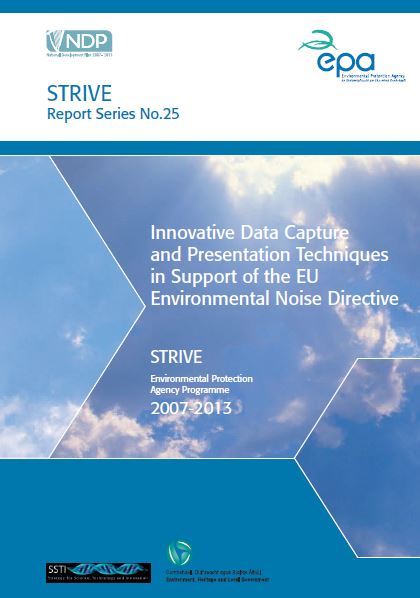Innovative Data Capture and Presentation Techniques in Support of the EU Environmental Noise Directive
Final Report for the ERTDI-funded project: 2005-UE-MS-44
Summary: STRIVE Report 25 - Gearóid Ó Riain and Tim McCarthy

The Environmental Protection Agency of Ireland (EPA) funded from 2006 to 2007 a research project to develop methodologies to meet data-related challenges arising under the European Union (EU) Environmental Noise Directive (END) (2002/49/EC) for Ireland. The research project sought to assess the role of advanced ground- and air-based spatial video and photography in the creation of data required for suitably accurate noise modelling in road environments.
These imagery sources can be processed and features recorded from the imagery, with these features in turn being used in environmental traffic noise models. The project undertook surveys using these spatial video and airborne imagery technologies to provide a plan and oblique view of the road environment, thereby facilitating a more complete characterisation of elements of the road environment that have an impact on noise propagation and attenuation.
Various features – including natural and artificial embankments and cuttings, buildings, road surfaces, along with vehicle numbers, type and driving speeds – all combine to affect how traffic-related noise is generated and propagated. Two essential pieces of information are needed in order to categorise these noise-related features: (i) the geometry (position, height, length) of these route-corridor features together with (ii) attribution describing the nature of the features (e.g. sound barrier, brick wall, grass embankment). Arising from the partners’ ongoing work in developing these spatial imagery technologies, it became apparent that these technologies had potential application in supporting the collection of the above data to support noise modelling of the road environment.
Custom software allowed a team of processors to view the spatial imagery and extract features describing the road environment (such as embankments, walls and noise barriers, bridges, and buildings); the software was also used to record the objects’ plan position and height. The data generated was used as an input to noise-modelling software.
A pilot noise-modelling exercise served to refine the features captured by the project team and led to fine-tuned processes for additional data capture and noise modelling. The data was actively used in the modelling of road noise by the National Roads Authority (NRA) while a separate follow-on project gathered additional data using the project techniques, supporting the NRA across the majority of routes required to be modelled under the Directive. This noise-modelling and mapping exercise conducted by the NRA was part of the first round of strategic noise mapping under the Environmental Noise Directive and required to be completed by 30 June 2007.
The techniques as developed through this project have proven their value in providing selected data requirements for noise modelling. In particular, the role of spatial video has been shown to be of value, supported by aerial imagery where existing mapping is not suitable and where additional plan-view verification of features is required.
Related research by the project partners continues the development of the project technologies and other advanced sensor technologies. The development and fusion of these technologies continues to offer real opportunities in assisting data collection to support the more extensive noise mapping required under further rounds of the Environmental Noise Directive.
Also available for download:
-
Print-Quality Version (i.e. high resolution PDF) of STRIVE Report 25